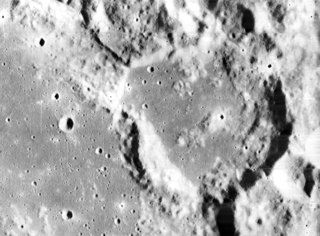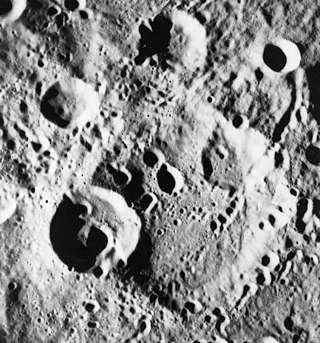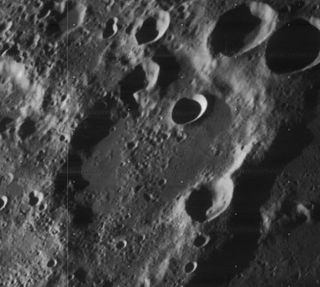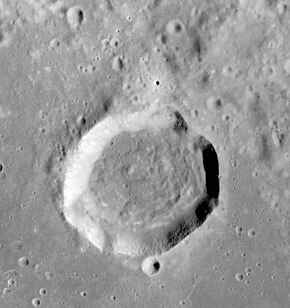
Beketov is a small lunar impact crater that lies in the northern reaches of the Mare Tranquillitatis. It is named after Russian chemist Nikolay Beketov. To the south is the ghost crater Jansen R. Northeast of Beketov, along the edge of the mare, is the crater Vitruvius. Beketov was previously designated Jansen C before being named by the IAU. The flooded crater Jansen itself lies to the south.

Proclus is a young lunar impact crater located to the west of the Mare Crisium, on the east shore of the Palus Somni. Its diameter is 27 km. It was named after 5th century Greek mathematician, astronomer and philosopher Proclus.

Gagarin is a large lunar impact crater that is located in the southern hemisphere on the far side of the Moon. To the southwest is the crater Pavlov and to the northeast lies Keeler. Closer to the rim are the craters Levi-Civita to the southwest, and Beijerinck to the north-northeast. Isaev lies entirely within the northwest rim of Gagarin. In contrast with the floor of Gagarin, Isaev has a floor with a somewhat low albedo.

Atwood is a small earth moon impact crater that is located on the Mare Fecunditatis, to the northwest of the prominent crater Langrenus. It forms a triple-crater formation with Naonobu attached to the north rim and Bilharz near the west rim.

Condon is a lunar impact crater that lies on the eastern shore of the Sinus Successus, a bay along the northeast edge of Mare Fecunditatis. It was named after American physicist Edward U. Condon in 1976. It lies midway between the larger crater Apollonius to the north and the smaller Webb to the south on the Mare Fecunditatis. Condon was previously designated Webb R.

Zhiritskiy is a lunar impact crater that is located on the far side of the Moon. It lies to the south of the large walled plain Fermi, and northwest of the crater Schaeberle.

Gilbert is a large lunar impact crater that lies near the eastern limb of the Moon. Due to its location this feature appears foreshortened when viewed from the Earth, limiting the amount of detail that can be observed. The crater lies to the northwest of the similar-sized walled plain Kästner, to the west of the Mare Smythii.

Gardner is a small lunar impact crater in the northeast part of the Moon. It was named after an American physicist Irvine Clifton Gardner in 1976. It lies due east of the crater Vitruvius, in a section of rough terrain north of the Mare Tranquillitatis. Gardner was previously designated Vitruvius A before being given its present name by the IAU. To the northeast of Gardner is the larger crater Maraldi.

Fabbroni is a small lunar impact crater that lies along the northern edge of the Mare Tranquillitatis, at the eastern edge of the gap where the lunar mare joins Mare Serenitatis to the north. To the southeast is the crater Vitruvius.

Esclangon is a lunar impact crater that is located in the rugged terrain to the northwest of the prominent crater Macrobius, and east of Sinus Amoris. Its diameter is 15 km. It was named after French astronomer Ernest Esclangon. This formation was previously designated Macrobius L. Just to the west-southwest is the crater Hill. Lacus Bonitatis, the Lake of Good, is located to the east and northeast of Esclangon.

Fermi is a large lunar impact crater of the category named a walled plain. It was named after Italian-American physicist and Nobel laureate Enrico Fermi. It lies on the far side of the Moon and can not be viewed from the Earth. Thus this feature must be viewed from an orbiting spacecraft.

Kästner is a lunar impact crater that is located near the eastern limb of the Moon, to the southwest of the Mare Smythii. Just to the northwest of Kästner is the walled plain Gilbert. To the south is the prominent crater Ansgarius, and to the southwest lies La Pérouse.

Lebesgue is a small lunar impact crater that is located near the eastern limb of the Moon. It lies in the southeastern part of the Mare Smythii, to the southeast of the crater Warner. The southeastern rim of Lebesgue is attached to a small crater that overlays the northwest rim of Swasey, so that the three form a short crater chain. The floor of Lebesgue is hummocky.

Ibn Firnas is a lunar impact crater on the far side of the Moon. Attached to the exterior of its southwestern rim is the prominent crater King. Only a few kilometers to the north, separated by a rugged stretch of terrain, is the larger crater Ostwald.

Danjon is a lunar impact crater on the far side of the Moon. It lies less than a crater diameter to the east-southeast of the larger crater Langemak. To the east-northeast of Danjon is the crater Perepelkin, and due south lies the walled plain Fermi.

D'Arsonval is a small lunar impact crater on the far side of the Moon. It is situated across the northeastern rim of the older and larger crater Danjon. To the west of D'Arsonval is Perepelkin.

Delporte is a lunar impact crater on the far side of the Moon. It overlies part of the northwestern rim of the huge walled plain Fermi, and the crater Litke is nearly attached to the southeastern rim.

Dobrovolʹskiy is a small lunar impact crater on the Moon's far side. The northwest part of its rim is intruded upon by the somewhat larger crater Shirakatsi, and the outer rampart of that feature covers most of the interior floor of Dobrovolʹskiy. Very little of the original floor now survives, with a small section near the southern inner wall. The remainder of the crater rim is somewhat circular and only mildly worn.

Erro is a lunar impact crater that lies beyond the eastern limb of the Moon, on the far side as seen from the Earth. It lies along the eastern fringes of the uneven plain that joins Mare Marginis to the northwest with Mare Smythii to the west-southwest. This part of the surface is sometimes brought into sight of observers on the Earth due to libration. However even at such times not much detail can be seen, as the surface is viewed from the edge.

Stark is a lunar impact crater on the far side of the Moon. It lies to the southeast of the prominent crater Tsiolkovskiy, and north of Subbotin.























